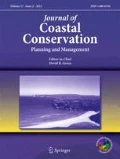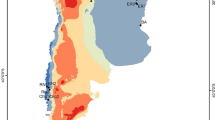Abstract
In Brazil, few studies have been conducted about the assimilation of carbon and biomass accumulation in mangroves despite its great role as a carbon sink. In this sense, this study aimed to estimate the aboveground biomass (AGB) and carbon stocked by mangrove species in a stretch along the Piraquê-Açu River in southeastern Brazil, and to verify their relation with some soil parameters. For such, the height and diameter of all trees inside six plots of 100 m2 were measured and used to quantify AGB through an allometric equation, and soil samples were collected to calculate granulometry, humidity, time of infiltration and permeability. Multiple regressions were used to identify relations between AGB and soil parameters. A total of 296 trees were found in the area and the AGB and carbon assimilated were 2.92 t ha−1 and 1.46 t ha−1, respectively. Laguncularia racemosa was the most abundant species and contributed with 61% of these values. Only a positive relation between AGB/carbon of L. racemosa and soil humidity was found, probably due to the substrate characteristics which contain a large concentration of silt/clay, and may store more water and do not yet provide firmness to the roots. By comparison, this mangrove had a low amount of AGB and carbon stocked and has yet to develop structurally. Along with other ecological functions and its associated ecosystem services such as supplying food for the local community, these features highlight the importance to conserve the studied mangrove and the interlinked coastal ecosystems.



Similar content being viewed by others
References
Alongi DM (2002) Present state and future of the world’s mangrove forests. Environ Conserv 29:331–349
Aracruz, Prefeitura Municipal de (2016) Atrações turísticas; Rio Piraquê-Açu. http://www.aracruz.es.gov.br/turismo/atracoes-turisticas/14/. Accessed 23 Nov 2016
Barbier EB, Hacker SD, Kennedy C, Koch EW, Stier AC, Silliman BR (2011) The value of estuarine and coastal ecosystem services. Ecol Monogr 81:169–193
Bernini E, Rezende CE (2004) Estrutura da vegetação em florestas de mangue do estuário do rio Paraíba do Sul, Estado do Rio de Janeiro, Brasil. Acta Bot Bras 18:491–502
Burger DM, Delitti WBC (2010) Modelos preditores da fitomassa aérea da Floresta Baixa de Restinga. Rev Bras Bot 33:143–153
Carvalho LC, Fonseca SM (2004) Quantificação da biomassa e do carbono em Rhizophora mangle, Avicennia schaueriana e Laguncularia racemosa no manguezal da laguna de Itaipu, Niterói-RJ. In: VI Simpósio de Ecossistemas Brasileiros, São José dos Campos. Anais... INPA 1:1–8
Cuzzuol GRF, Campos A (2001) Aspectos nutricionais na vegetação de manguezal do estuário do Rio Mucuri, Bahia, Brasil. Rev Bras Bot 24:227–234
Donato DC, Kauffman JB, Murdiyarso D, Kurnianto S, Stidham M, Kanninen M (2011) Mangroves among the most carbon-rich forests in the tropics. Nat Geosci 4:293–297
Fromard F, Puif H, Mougin E, Marty G, Betoulle JL, Cadamuro L (1998) Structure, above-ground biomass and dynamics of mangrove ecosystems: new data from French Guiana. Oecol 115:39–53
Hammer O, Harper DAT, Ryan PD (2001) PAST: Paleontological Statistics software package for education and data analysis. Palaeontol Electron 4(1):9 pp
Kathiresan K (2012) Importance of mangrove ecosystem. Int J Mar Sci 10:70–89
Kathiresan K, Bingham BL (2001) Biology of mangroves and mangrove ecosystems. Adv Mar Biol 40:81–251
Kathiresan K, Anduraj R, Gomathi V, Saravanakumar K (2013) Carbon sequestration potential of Rhizophora mucronata and Avicennia marina as influenced by age, season, growth and sediment characteristics in southeast coast of India. J Coast Conserv 17:397–408
Kauffman JB, Heider C, Norfolk J, Payton F (2014) Carbon stocks of intact mangroves and carbon emissions arising from their conversion in the Dominican Republic. Ecol Appl 24:518–527
Komiyama A, Poungparn S, Kato S (2005) Common allometric equations for estimating the tree weight of mangroves. J Trop Ecol 21:471–477
Komiyama A, Ong JE, Poungparn S (2008) Allometry, biomass, and productivity of mangrove forests: a review. Aquat Bot 89:128–137
Lacerda LD (1998) Trace metals biogeochemistry and diffuse pollution in mangrove ecosystems. International Society for Mangrove Ecosystem. Japan, 65 p
Larcher W (2000) Ecofisiologia Vegetal. Prado CHBA (trad) RiMA Artes e Textos, São Carlos 531 p
Lee SY, Primavera JH, Dahdouh-Guebas F et al (2014) Ecological role and services of tropical mangrove ecosystems: a reassessment. Glob Ecol Biogeogr 23:726–743
Liu H, Ren H, Hui D, Wang W, Liao B, Cao Q (2014) Carbon stocks and potential carbon storage in the mangrove forests of China. J Environ Manag 133:86–93
Londe V, Salles DM, Leite MGP (2013) Estrutura da vegetação de mangue associada ao gradiente de inundação no litoral norte do Espírito Santo, Brasil. Rev Arv 37:629–637
Mckee K (1993) Soil physicochemical patterns and mangrove species distribution – reciprocal effects? J Ecol 81:477–487
McLeod EG, Chmura GL, Bouillon S, Salm R, Bjork M, Duarte CM, Lovelock CE, Schlesinger WH, Silliman BR (2011) A blueprint for blue carbon: toward an improved understanding of the role of vegetated coastal habitats in sequestering CO2. Front Ecol Environ 9:552–560
Mumby PJ (2006) Connectivity of reef fish between mangroves and coral reefs: algorithms for the design of marine reserves at seascape scales. Biol Conserv 128:215–222
Pendleton L, Donato DC, Murray BC et al (2012) Estimating global “blue carbon” emissions from conversions and degradation of vegetated coastal ecosystems. PLoS One 9:e43542. doi:10.1371/journal.pone.0043542
R Core Team (2015) R: a language and environment for statistical computing. R Foundation for Statistical Computing, Vienna, Austria. http://www.R-project.org/
Ribeiro SC, Jacovine LAG, Soares CPB et al (2009) Quantification of biomass and estimation of carbon stock in a mature forest in the municipal district of Viçosa, Minas Gerais. Rev Árv 33:917–926
Schaeffer-Novelli Y, Cintrón G (1986) Guia para estudos de áreas de manguezal: estrutura, função e flora. Caribbean Ecological Research, São Paulo 150 p
Semesi AK, Howell K (1992) The mangroves of the eastern African region. United Nations Environment Programme, Nairobi
Silva CA, Lacerda LD, Rezende CE (1990) Metals reservoir in a red mangrove forest. Biotropica 22:339–345
Silva MAB, Bernini E, Carmo MS (2005) Características estruturais de bosques de mangue do estuário do Rio São Mateus, ES, Brasil. Acta Bot Bras 19:465–471
Soares MLG (1999) Estrutura vegetal e grau de perturbação dos manguezais da Lagoa da Tijuca, Rio de Janeiro, Brasil. Rev Bras Biol 59:503–515
Steinke TD, Ward CJ, Rajh A (1995) Forest structure and biomass of mangroves in the Mgeni estuary, South Africa. Hydrobiol 295:159–166
Suguio K (1973) Introdução à sedimentologia. Edgard Blüncher, EDUSP, São Paulo 318 p
Van TT, Wilson N, Thanh-Tung H, Quisthoudt K et al (2015) Changes in mangrove vegetation area and character in a war and land use change affected region of Vietnam (Mui Ca Mau) over six decades. Acta Oecol 63:71–81
Vieira SA, Alves LF, Aidar M et al (2008) Estimation of biomass and carbon stocks: the case of the Atlantic Forest. Biota Neotrop 8:21–29
Wood Density Database (2015) Tree functional attributes and ecological database. http://db.worldagroforestry.org//wd. Accessed 15 Aug 2015
Acknowledgements
Authors are grateful to CAPES (Coordination for the Improvement of the Higher Education Personnel) by their master’s scholarship, to PROPP (Department of research and graduate programs) and PPG-BIOMAS (Graduate Program in Ecology of Tropical Biomes), both from the Federal University of Ouro Preto (UFOP), by their logistical and financial support during the field course of 2011.
Author information
Authors and Affiliations
Corresponding author
Additional information
An erratum to this article is available at http://dx.doi.org/10.1007/s11852-017-0528-2.
Rights and permissions
About this article
Cite this article
da Motta Portillo, J.T., Londe, V. & Moreira, F.W.A. Aboveground biomass and carbon stock are related with soil humidity in a mangrove at the Piraquê-Açu River, Southeastern Brazil. J Coast Conserv 21, 139–144 (2017). https://doi.org/10.1007/s11852-016-0482-4
Received:
Revised:
Accepted:
Published:
Issue Date:
DOI: https://doi.org/10.1007/s11852-016-0482-4




